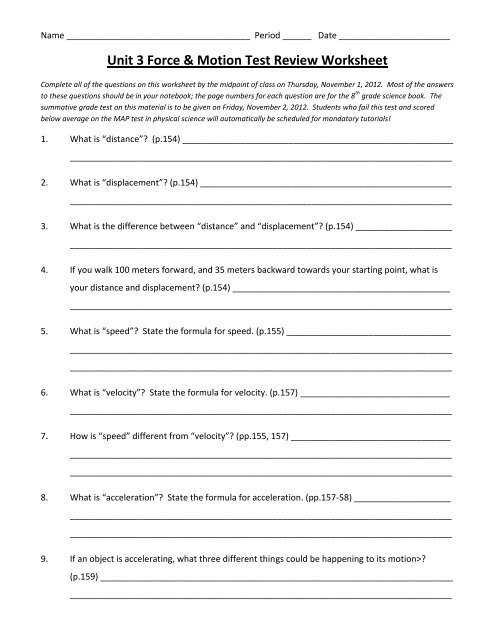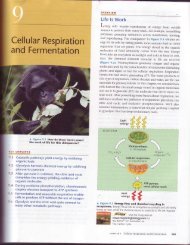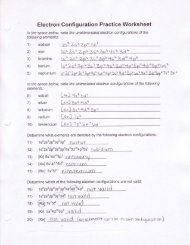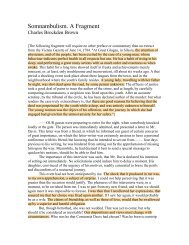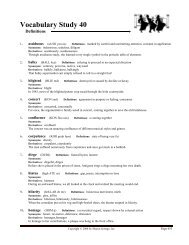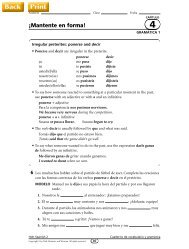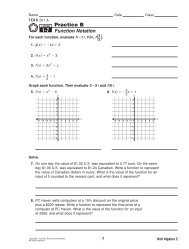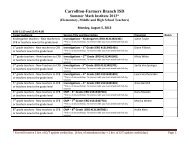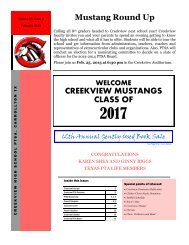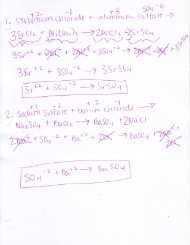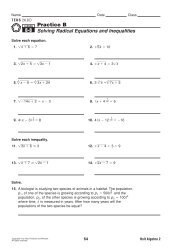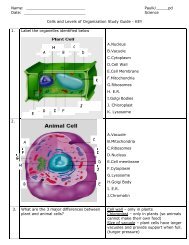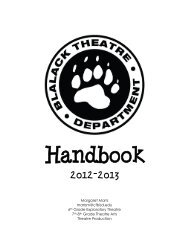Unit 3 Force & Motion Test Review Worksheet
Unit 3 Force & Motion Test Review Worksheet
Unit 3 Force & Motion Test Review Worksheet
You also want an ePaper? Increase the reach of your titles
YUMPU automatically turns print PDFs into web optimized ePapers that Google loves.
Name ______________________________________ Period ______ Date _______________________<br />
<strong>Unit</strong> 3 <strong>Force</strong> & <strong>Motion</strong> <strong>Test</strong> <strong>Review</strong> <strong>Worksheet</strong><br />
Complete all of the questions on this worksheet by the midpoint of class on Thursday, November 1, 2012. Most of the answers<br />
to these questions should be in your notebook; the page numbers for each question are for the 8 th grade science book. The<br />
summative grade test on this material is to be given on Friday, November 2, 2012. Students who fail this test and scored<br />
below average on the MAP test in physical science will automatically be scheduled for mandatory tutorials!<br />
1. What is “distance”? (p.154) ________________________________________________________<br />
_______________________________________________________________________________<br />
2. What is “displacement”? (p.154) ____________________________________________________<br />
_______________________________________________________________________________<br />
3. What is the difference between “distance” and “displacement”? (p.154) ____________________<br />
_______________________________________________________________________________<br />
4. If you walk 100 meters forward, and 35 meters backward towards your starting point, what is<br />
your distance and displacement? (p.154) _____________________________________________<br />
_______________________________________________________________________________<br />
5. What is “speed”? State the formula for speed. (p.155) __________________________________<br />
_______________________________________________________________________________<br />
_______________________________________________________________________________<br />
6. What is “velocity”? State the formula for velocity. (p.157) _______________________________<br />
_______________________________________________________________________________<br />
7. How is “speed” different from “velocity”? (pp.155, 157) _________________________________<br />
_______________________________________________________________________________<br />
_______________________________________________________________________________<br />
8. What is “acceleration”? State the formula for acceleration. (pp.157-58) ____________________<br />
_______________________________________________________________________________<br />
_______________________________________________________________________________<br />
9. If an object is accelerating, what three different things could be happening to its motion>?<br />
(p.159) _________________________________________________________________________<br />
_______________________________________________________________________________
10. Describe the motion of an object that has negative acceleration. (p.159) ____________________<br />
_______________________________________________________________________________<br />
11. If a plane is flying at a constant speed but turning to a new direction, what is happening to its<br />
velocity and acceleration? (p.159) ___________________________________________________<br />
_______________________________________________________________________________<br />
12. A car travels a distance of 240 kilometers in 4 hours. What is its speed in kilometers per hour?<br />
____________________________________<br />
13. A car has a displacement of 400 kilometers to the east in 5 hours. What is its velocity in<br />
kilometers per hour? _____________________________________<br />
14. If a car is traveling at a constant speed of 80 kilometers per hour (km/h), how many hours will it<br />
take for the car to travel a distance of 480 kilometers? _________________________________<br />
15. If a car moves at a speed of 60 km/h for 4 hours, what distance will it travel?<br />
______________________<br />
16. If the velocity of a car changes from 10 meters per second (m/s) to 70 m/s in 4 seconds, what is<br />
the acceleration over that 4 second period? ______________________________<br />
17. If the velocity of a car changes from 80 km/hr to 0 km/hr in 4 seconds, what is the acceleration<br />
over that 10 second period? _________________________<br />
18. In a graph showing distance travelled on the y-axis and time on the x-axis, what does each of the<br />
following graphed lines indicate? A horizontal line: ____________________________________<br />
A straight line with constant slope: __________________________________________________<br />
A straight line with a shallow upward slope: ___________________________________________<br />
A straight line with a steep upward slope: _____________________________________________<br />
A upwardly curving line: ___________________________________________________________<br />
19. What is a force? (p.160) ___________________________________________________________<br />
20. What two separate measurements are needed to describe a force? (p.160) __________________<br />
_______________________________________________________________________________<br />
21. State Newton’s First Law of <strong>Motion</strong>. (p.161) ___________________________________________<br />
_______________________________________________________________________________
_______________________________________________________________________________<br />
_______________________________________________________________________________<br />
22. How can the need for seat belts in cars be explained using Newton’s First Law of <strong>Motion</strong>? (p.161)<br />
_______________________________________________________________________________<br />
_______________________________________________________________________________<br />
23. What is inertia? How are mass and inertia related? (p.162) ______________________________<br />
_______________________________________________________________________________<br />
_______________________________________________________________________________<br />
25. What are balanced forces? (p.162) __________________________________________________<br />
_______________________________________________________________________________<br />
26. How do balanced forces affect the motion of objects? (p.162) _____________________________<br />
_______________________________________________________________________________<br />
27. Describe all of the forces acting on a car moving at a constant velocity. (p.162) _______________<br />
_______________________________________________________________________________<br />
28. What are unbalanced forces? (pp.162-63) ____________________________________________<br />
_______________________________________________________________________________<br />
29. How do unbalanced forces affect the motion of an object? (p.163) _________________________<br />
_______________________________________________________________________________<br />
30. State Newton’s Second Law of <strong>Motion</strong>. (p.164) _________________________________________<br />
_______________________________________________________________________________<br />
_______________________________________________________________________________<br />
_______________________________________________________________________________<br />
31. State the formula for Newton’s Second Law of <strong>Motion</strong> in its three possible forms, solving for<br />
mass, acceleration or force. (pp.164-65) ______________________________________________<br />
_______________________________________________________________________________<br />
32. State the formula for<br />
Newton’s 2 nd Law of <strong>Motion</strong>,<br />
using the triangle format.
33. What are the standard metric units of measurement in the formulas for Newton’s Second Law of<br />
<strong>Motion</strong>? (p.165) _________________________________________________________________<br />
_______________________________________________________________________________<br />
34. If a force is applied to three different objects, each with a different mass, which of the objects<br />
will accelerate the fastest? _________________________________________________________<br />
35. What is the amount of acceleration caused by the Earth’s gravity near the Earth’s surface?<br />
(p.166) _________________________________________________________________________<br />
36. What is “weight”? (p.166) _________________________________________________________<br />
37. What is friction? (p.167) ___________________________________________________________<br />
_______________________________________________________________________________<br />
38. What is air resistance? How does air resistance slow the fall rate of a parachute? (p.170) _______<br />
_______________________________________________________________________________<br />
_______________________________________________________________________________<br />
39. State Newton’s Third Law of <strong>Motion</strong>. (p.172) __________________________________________<br />
_______________________________________________________________________________<br />
40. State the action and reaction forces in a rocket taking off from a launching pad. (p.172) ________<br />
_______________________________________________________________________________<br />
41. An object with a mass of 5.0 kg accelerates 8.0 m/s 2 when an unknown force is applied to it.<br />
What is the amount of the force? ______________________<br />
42. An object accelerates 2.0 m/s 2 when a force of 12.0 newtons is applied to it. What is the mass of<br />
the object? ___________________________<br />
43. An object with a mass of 3.0 kg has a force of 9.0 newtons applied to it. What is the resulting<br />
acceleration of the object? ________________________<br />
44. If a man with a mass of 100 kg travels to the Moon, where the acceleration due to gravity is 1.5<br />
m/s 2 , what will his weight be on the Moon? ___________________________


